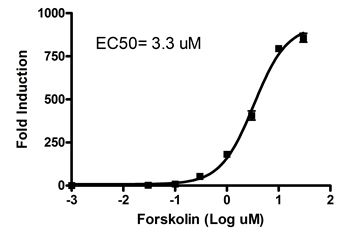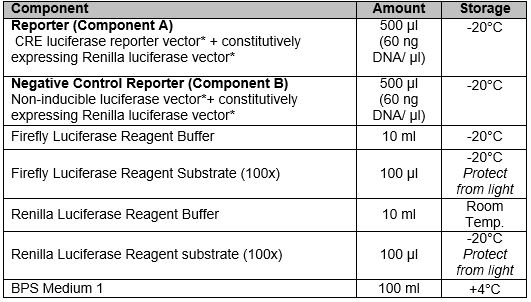Transfection Collection™ : CRE/CREB Transient Pack (cAMP/PKA Cell Signaling Pathway)
The CRE/CREB Transient Pack is designed to provide the tools necessary for transiently transfecting and monitoring the activity of the cAMP/PKA signaling pathway in cultured cells. The kit contains transfection-ready vectors containing firefly luciferase as a cAMP/PKA pathway-responsive reporter and constitutively expressing Renilla luciferase as a transfection control. It also includes the TWO-Step Luciferase detection reagents to detect both luciferase activities and specialized medium for growing and assaying HEK293 cells.
The key to the CRE/CREB Transient Pack is the CRE/CREB luciferase reporter vector, which is a cAMP/PKA Cell Signaling Pathway-responsive reporter. This reporter contains the firefly luciferase gene under the control of multimerized cAMP response elements (CRE) located upstream of a minimal promoter. Elevation of the intracellular cAMP level activates cAMP response element binding protein (CREB) to bind CRE and induces the expression of luciferase.
The CRE reporter is premixed with constitutively-expressing Renilla (sea pansy) luciferase vector that serves as an internal control for transfection efficiency. The kit also includes a non-inducible firefly luciferase vector premixed with the constitutively-expressing Renilla luciferase vector as a negative control. The non-inducible luciferase vector contains the firefly luciferase gene under the control of a minimal promoter, but without any additional response elements. The negative control is critical to determining pathway-specific effects and background luciferase activity.
Additionally, the pack includes cell culture medium (BPS Medium 1) that has been optimized for use with HEK293 cells*. BPS Medium 1 includes MEM medium, 10% fetal bovine serum, 1% non-essential amino acids, sodium pyruvate, and 1% Pen/Strep. Finally, the pack provides the TWO-Step Luciferase (Firefly & Renilla) Assay System. These luciferase reagents provide highly sensitive, stable detection of firefly luciferase activity and Renilla luciferase activity. The TWO-step luciferase reagents can be used directly in cells in growth medium and can be detected with any luminometer; automated injectors are not required.
* Other mammalian cell lines may also be used, but an alternate cell culture medium may be required for optimal cell growth.
Purchase of this cell line is for research purposes only; commercial use requires a separate license. View the full terms and conditions.
The main role of the cAMP response element, or CRE, is mediating the effects of Protein Kinase A (PKA) by way of transcription. It is the main binding site of CREB and is responsible for its activation. CRE is at the focus of many extracellular and intracellular signaling pathways, including cAMP, calcium, GPCR (G-protein coupled receptors) and neurotrophins. The cAMP/PKA signaling pathway is critical to numerous life processes and living organisms. In the cAMP/PKA signaling pathway, CREB is activated via phosphorylation of PKA and binds to CRE with a general motif of 5’-TGACGTCA-3’. Since CRE is a modulator of the cAMP/PKA signaling pathway, it allows the effects of various inhibitors to be studied.
2. Fan Chung, K. (2006) Phosphodiesterase inhibitors in airways disease. Eur. J. Pharmacol. 533(1-3):110-117.
3. Malik, R. et al. (2008) Cloning, stable expression of human phosphodiesterase 7A and development of an assay for screening of PDE7 selective inhibitors. Appl. Microbiol. Biotechnol. 77 (5): 1167-1173.




